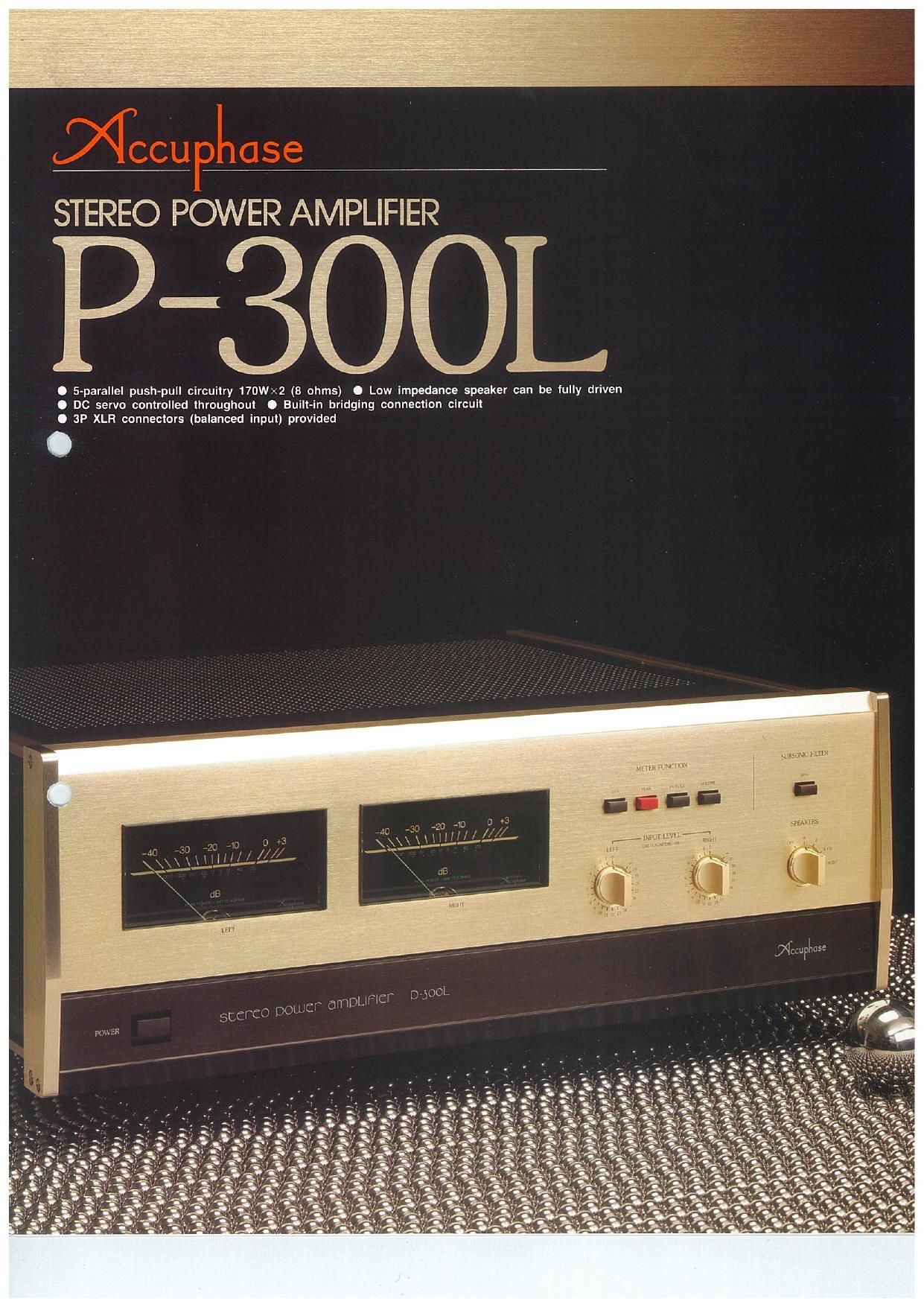Accuphase P 300 L Brochure
This is the 6 pages manual for Accuphase P 300 L Brochure.
Read or download the pdf for free.
If you want to contribute, please mail your pdfs to info@audioservicemanuals.com.

Extracted text from Accuphase P 300 L Brochure (Ocr-read)
Page 1
STEREO POWER AMPLIFIER
pull circuitry 17!)sz (8 ohms) 0 Low impedance speaker can be fully driven
In bridging connection crrcult
DC servo controlled throughout 0 Bullt
3P XLR connectors (balanced input) provided
5-parallel push
rmltll
Page 2
The advent of digital recordings (PCM) and
compact discs (CD) reveals a growing trend
toward digitization of audio equipment, and
reproduction of high-fidelity sound that differs
from conventional analog recordings is now
expected. Parallel to this trend. the reproduc~
tion capabilities of conventional analog discs
with a history of more than a century have
shown a significant amelioration resulting from
the improvement of cartridges, record players,
amplifiers, and other equipment.
The P-SOOL adopts the state-ofvthe~art tech-
nologies and the Accuphase circuit design
philosophy of Push»Pull Circuitry in every
stage"
Higher-grade power amplifiers must be
endowed not only with superior basic charac-
teristics such as frequency characteristics. low
distortion ratio. higher signal-to-noise ratio. but
with the capability and power to drive speakers
correctly with ample energy so that they can
respond accurately to instantly changing, wide-
ranging signal variations. This necessitates a
power supply with an ample reserve margin to
provide the full energy that is required by a
powerful output circuit driven by a large current
capacity driver stage.
OUTPUT STAGE CONSISTING 0F
5-PARALLEL PUSH-PULL CIR-
CUITRV GUARANTEES 300W/ch
AT 2- OHM LOAD, 170 W/ch AT
8-OHM LOAD
Fig. i shows the amplifier circuit diagram which
is the heart of the P«300L. The output stage is
composed of 5-parallel pushpull circuitry that
includes to transistors (0.7 through 025), Each
transistor has maximum power dissipation (Pc)
of 100 watts. resulting in a total capacitance of
1 kW, The transistors are mounted to a large»
Sized aluminum heat sink that adequately
dissipate the heat generated so that an output
of i70 watts per channel (20-20000 Hz; total
harmonic distortion of no more than 001%) is
obtained at 8-ohm load.
The impedance of speakers vary greatly
according to the input signal frequencies. The
impedance of some speakers decreases to half
or less of the nominal value, To supply power
with proper linearity to such speakers, the
speakers must be driven by a power amplifier
capable of supplying a sufficient output at low
load impedance. The P-300L is able to transmit
the exact replica of the input signals to speak-
ers at as low a load impedance as 2 ohms
thanks to the highrpower output stage and
powerful power supply. The PVSOOL provides
the rated output of 300 watts per channel at
Zeohm load.
Distortion of low»|evel signals at the output
stage seriously degrades sound quality. The
distortion occurs especially when the crossover
As a result of emphasis on the improvement
of sound quality. the P-300L incorporates a
power supply comprising a large-sized toroidal
transformer and two capacitors each of which
with a capacitance of 47.000 uF. Moreover. the
P-300L is provided with a powerful output stage
with a low impedance. This output stage
consists of five parallel push-pull circuits each
comprising 2 output transistors. The maximum
power dissipation (Pc) of each of the 10
transistors is 100 watts. The P-SOOL can be thus
driven at a low impedance providing an out-.
standing output. For example. the output is 170
watts per channel (20-20000 Hz. total harmon-
ic distortion of not more than 0.01%) when
connected to an B-ohm load and 300 watts per
channel when connected to a 2-ohm load. The
P-300L can therefore supply a stable energy to
such speakers whose impedance greatly
fluctuates and thereby can substantially im-
prove the linearity of audio signals. Now. the
dynamism of music can be perfectly repro-
duced.
Each of the driver stages supplying signals
to the output stage constitutes a cascode
push-pull circuit realizing a sufficiently wide
band and low harmonic distortion within the
loop. The higheouality and stable drive that the
P-SOOL features is thus realized.
The P~3OOL is provided with 600~ohm Bal»
anced type Input Connectors that exactly
matches the BOO-ohm balanced type output
lines of Accuphase Stereo Preamplifiers 0-280
and CVZOOL. Degradation of sound quality due
to noises picked up by the signal cables
between the preamplifier and the power am~
plilier is therefore eliminated.
Moreover. since the P-300L incorporates a
bridging connection. the output of the P-SOOL
can be increased to 500 watts (when con-
nected to an B-ohm load) to serve as a
monophonic amplifier thus upgrading the ut-
put and satisfying the demands for aQ
dynamic range that is essential in the pr nt
era.
To obtain a high-quality reproduction. good
quality of low- level signals is vital. The P-aOOL
is provided with ClassA driver stages. MOS
FET driver circuitry, and output circuitry free
from crossover distortion to maintain excellent
sound quality of low listening level.
The P-300l. can be combined with not only
the C-200L Stereo Control Center but also any
model of Accuphase preamplifiers.
+Bi
+52
Fig. 1 P-aooL Circuit Diagram
point of the operations of the push-pull circuits.
each comprising a PNP transistor and an NPN
transistor, are not performed successively. or
when one of the paired transistors is in the
cutofl state. To prevent such distortion. the
P-300L is designed for no crossover distortion.
which provides a prominently elegant sound of
low-level signals despite the fact that the
P-300L is designed to produce a h'gh output
CASCODE PUSH-PULL AND
MOS FET CASCODE PUSH-PULL
CIRCUITRY DRIVER STAGE
REALIZES EXCELLENT
LINEARITY, HIGH-FREQUENCY
CHARACTERISTICS, AND LOW
HARMONIC DISTORTION'OF
LOW-LEVEL SIGNAL
Unlike amplifiers for large auditoriums. amr
plifiers for noncommercial purposes are used in
a situation where the distance between the
listener and speakers is short Therefore. sound